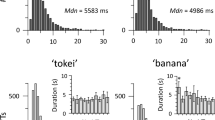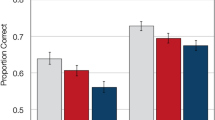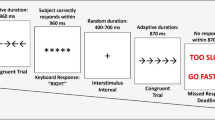Summary
Verbal material was presented to 28 Ss for reproduction in the dichotic-listening-method in order to analyse the laterality effect. The distribution of attention as well as the sequence of reproduction of the items was varied through different instruction.
The results are as follows:
-
1.
We succeeded in replicating the laterality effect reported in literature.
-
2.
Reproduction performance from the left as well as from the right increases significantly in that part of the experiment in which S pays attention to one side only.
-
3.
In spite of this increase in reproduction performance on both sides a significant laterality difference could also be shown in this particular situation.
-
4.
This effect was not influenced by the lenght of our experiment.
-
5.
When reproducing with attention focused on the items arriving at the left ear, Ss are less able to filter out items arriving simultanously at the right ear; right ear items are remembered and reproduced in this situation more often than left ear items in the opposite experimental situation.
Zusammenfassung
Mit der Dichotic-Listening-Methode wurde 28 Vpn verbales Material zur Reproduktion dargeboten, um den in der Literatur vielfach diskutierten Lateralitätseffekt zu analysieren. Die Aufmerksamkeitsverteilung wie auch die Reproduktionsabfolge der Items wurde durch Instruktion variiert.
Die Ergebnisse sind folgende:
-
1.
Der in der Literatur bekannte Lateralitätseffekt konnte repliziert werden.
-
2.
Die Reproduktionsleistung steigt sowohl von rechts wie von links in dem Teil des Versuchs signifikant an, in welchem die Aufmerksamkeit durch spezifische Instruktion nur auf eine Seite gerichtet ist.
-
3.
Trotz des Anstiegs der Reproduktionsleistung auf beiden Seiten konnte ein signifikanter Lateralitätseffekt auch in dieser Situation noch gesichert werden.
-
4.
Dieser Effekt ist auch nicht durch eine Übungsphase in der hier verwendeten Länge auszuschließen.
-
5.
Bei der Reproduktion bei gerichteter Aufmerksamkeit „nur von links“ wird signifikant häufiger als in der entsprechenden Situation „nur von rechts“ die „Abschirmung“ durchbrochen, d.h. von der anderen (rechten) Seite eingelaufene Reize mit erinnert und angesagt.
Similar content being viewed by others
Literatur
Bakker, D. J.: Left-right differences in auditory perception of verbal and non-verbal material by children. Quart. J. exp. Psychol. 19, 334–336 (1967).
Bartz, W. H., Satz, P., Fennell, E., Lally, J. R.: Meaningfulness and laterality in dichotic listening. J. exp. Psychol. 73, 204–210 (1967).
Bever, Th. G.: The nature of cerebral dominance in speech behavior of the child and adult. In: Huxley und Ingram (eds.), Mechanism of language development. London: Academic Press 1970.
—, Kirk, R., Lackner, J.: An autonomic reflection of syntactic structure. Neuropsychologia 6, 81–85 (1968).
Bonin, G. v.: Anatomical asymmetries of the cerebral hemispheres. In: Interhemispheric relations and cerebral dominance. Ed. Mountcastle. Baltimore: Hopkins Press 1962.
Branch, C., Milner, B., Rasmussen, Th.: Intracarotid sodium amytal for the lateralization of cerebral speech dominance. J. Neurosurg. 12, 399–405 (1964).
Broadbent, D. E.: The role of auditory localization in attention and memory span. J. exp. Psychol. 47, 191–196 (1954).
—: Immediate memory and simultaneous stimuli. Quart. J. exp. Psychol. 9, 1–11 (1957a).
—: A mechanical model for human attention and immediate memory. Psychol. Rev. 64, 205–215 (1967b).
—: Perception and communication. London: Pergamon Press 1958.
—, Gregory, M.: Accuracy of recognition for speech presented to the right and left ears. Quart. J. exp. Psychol. 16, 359–360 (1964).
Bryden, M. P.: Ear preference in auditory perception. J. exp. Psychol. 65, 103–105 (1963).
Caird, W. K.: Effects of age on the recall of dichotic words. Nature 207, 109 (Lond.) (1965).
Carey, P., Mehler, J., Bever, Th. G.: Judging the veracity of ambiguous sentences. J. verb. learn. beh. 9, 243–254 (1970).
Cooper, A., Achenbach, K., Satz, P., Leuy, C. M.: Order of report and ear asymmetry in dichotic listening. Psychon. Sci. 9, 96–98 (1967).
Curry, F. K.: A comparison of left-handed and right-handed subjects on verbal and non-verbal dichotic listening tasks. Cortex 3, 343–352 (1967).
—, Rutherford, D. R.: Recognition and recall of dichotically presented verbal stimuli by right- and left-handed persons. Neuropsychologia 5, 119–126 (1967).
Foss, D. J., Bever, Th. G., Silver, M.: The comprehension and verification of ambiguous sentences. Perception and Psychophysics 4, 304–306 (1968).
Inglis, J.: Dichotic stimulation and memory disorder. Nature (Lond.) 186, 181–182 (1960.)
—: Dichotic listening and cerebral dominance. Acta oto-laryng. (Stockh.) 60, 231–238 (1965).
—: On the relative effects of different sources of variation in dichotic listening performance. Brit. J. Psychol. 59, 415–433 (1968).
—, Ankus, M. N.: Effects of age on short-term storage and serial rote learning. Brit. J. Psychol. 56, 183–196 (1965).
—, Caird, W. K.: Age differences in successive responses to simultaneous stimulation. Canadian J. Psychol. 17, 98–105 (1963).
—, Tansey, C. L.: Age differences and scoring differences in dichotic listening performance. J. Psychol. 66, 325–332 (1967).
Kimura, D.: Visual and auditory perception after temporal lobe damage. Unpublished doctoral thesis Mc. Gill. Univ. 1960.
—: Cerebral dominance and the perception of verbal stimuli. Canadian J. Psychol. 15, 166–171 (1961a).
—: Some effects of temporal lobe damage on auditory perception. Canadian J. Psychol. 15, 156–165 (1961b).
—: A note on cerebral dominance in hearing. Acta oto-laryng. (Stockh.) 56, 617–618 (1963).
—: Left-right differences in the perception of melodies. Quart. J. exp. Psychol. 16, 355–358 (1964).
Sokolov, E. N.: Neuronal models and the orienting reflex. In: Brazier (ed.), The central nervous system and behavior. Third Conference 187–212 (1960).
Treisman, A. M., Geffen, G.: Selective attention and cerebral dominance in perceiving and responding to speech messages. Quart. J. exp. Psychol. 20, 139–150 (1968).
—, Rilley, J. G.: Is selective attention selective perception or selective response ? A further test. J. exp. Psychol. 79, 27–34 (1969).
Author information
Authors and Affiliations
Rights and permissions
About this article
Cite this article
Mainka, G., Hörmann, H. Genügt der Begriff „Aufmerksamkeit“ zur Erklärung des sogenannten Lateralitätseffekts ?. Psychol. Forsch. 34, 295–311 (1971). https://doi.org/10.1007/BF00424729
Received:
Issue Date:
DOI: https://doi.org/10.1007/BF00424729




